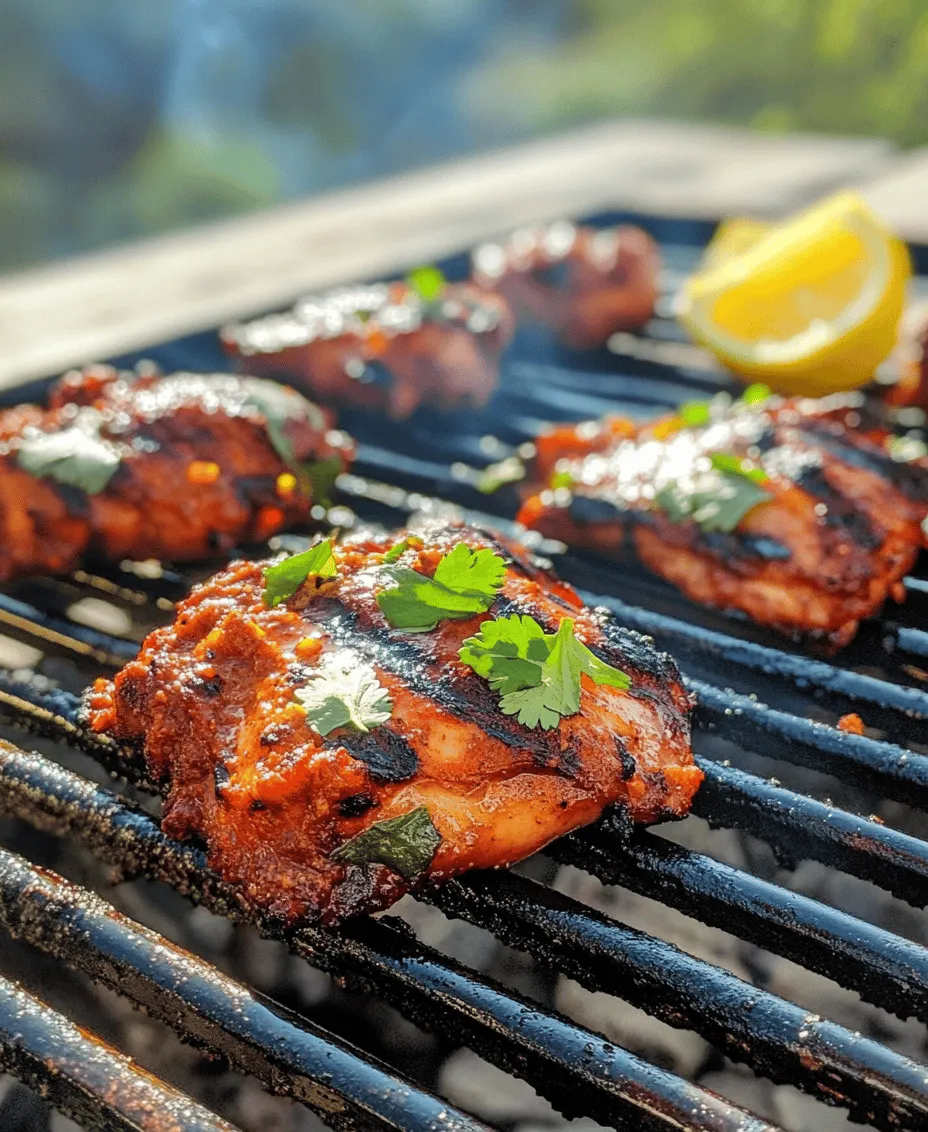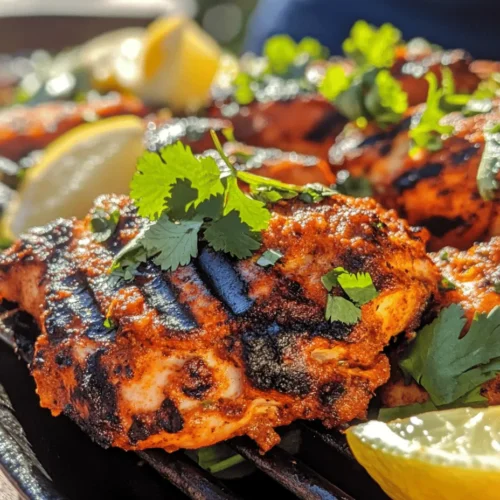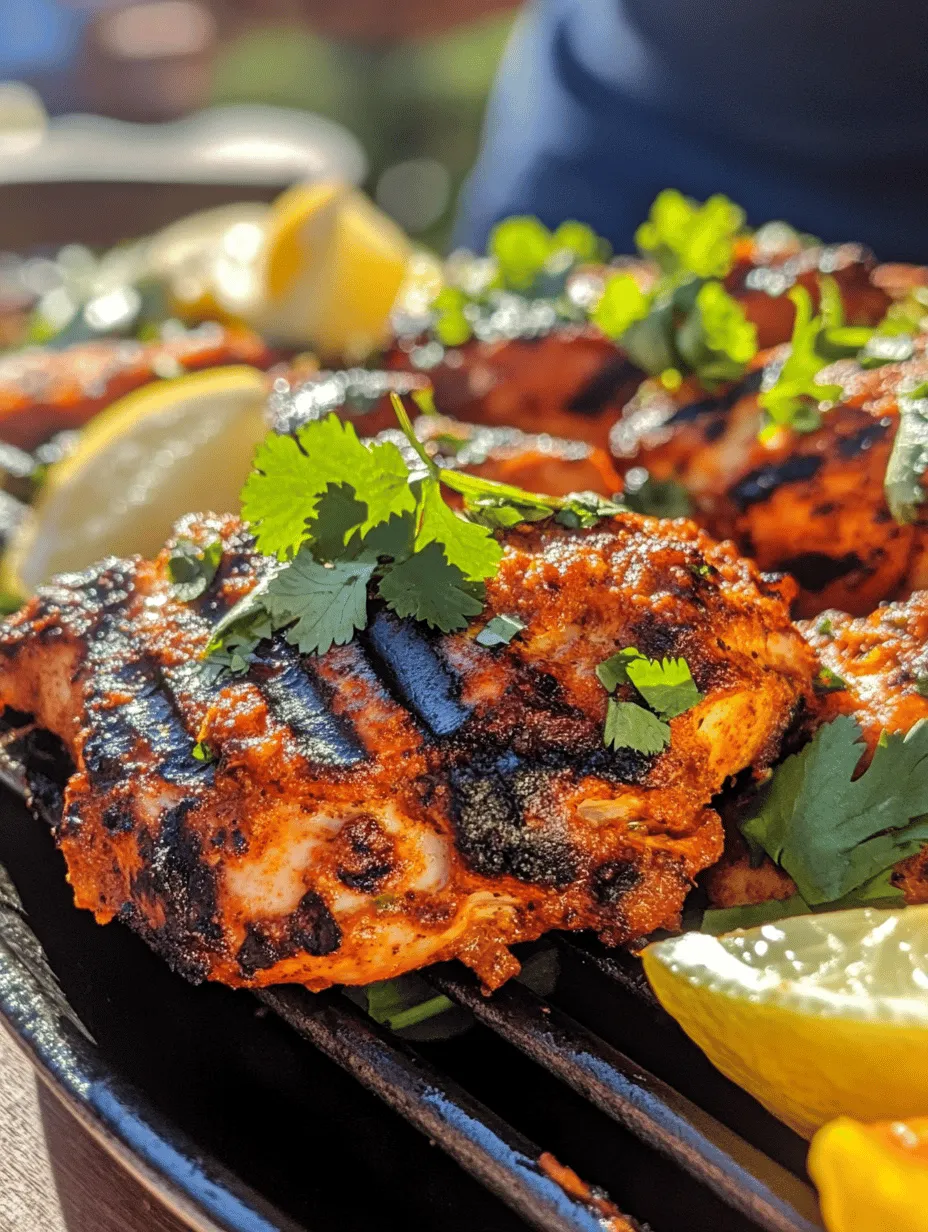Introduction
Tandoori chicken is more than just a dish; it’s a culinary experience that epitomizes the rich tapestry of Indian cuisine. Revered for its vibrant flavor profile and beautiful charred exterior, Tandoori chicken has become a favorite not only in India but also across the globe. Marinated in a blend of spices and yogurt, this dish stands out for its tender, juicy meat and smoky aroma, making it a go-to choice for gatherings, family dinners, and festive occasions.
The art of marinating is crucial when it comes to Tandoori chicken. The marination process not only infuses the chicken with deep flavors but also enhances its tenderness, ensuring that each bite is succulent and satisfying. Whether you’re planning a summer BBQ or a cozy family meal, this Tandoori chicken recipe promises to be a crowd-pleaser, impressing your guests with its authentic taste and aroma.
Understanding Tandoori Cooking
To truly appreciate Tandoori chicken, it’s essential to understand the cooking method and its historical roots. The term “Tandoori” refers to the traditional clay oven, known as a tandoor, used in Indian cooking. This method originated in the Indian subcontinent, dating back centuries, and is characterized by its ability to reach high temperatures, which are ideal for grilling and baking. The intense heat of the tandoor locks in moisture while creating a unique smoky flavor that is hard to replicate with conventional cooking techniques.
At the heart of Tandoori cooking lies a distinctive blend of spices known as Tandoori masala. This spice mix typically includes ingredients such as cumin, coriander, turmeric, and garam masala, each contributing to the dish’s unique flavor and aroma. These spices not only tantalize the taste buds but also offer numerous health benefits, including anti-inflammatory and antioxidant properties.
Another key player in Tandoori marinades is yogurt. This ingredient serves multiple purposes: it acts as a tenderizer, helps to bind the spices to the chicken, and adds a creamy texture that enhances the overall dish. The lactic acid in yogurt breaks down the proteins in the meat, resulting in a more flavorful and tender chicken.
Ingredients Breakdown
Understanding the ingredients used in Tandoori chicken is vital to crafting the perfect dish. Each component plays a significant role in enhancing flavor, texture, and overall appeal.
Chicken Thighs vs. Drumsticks
When it comes to chicken, the choice between thighs and drumsticks can significantly affect your dish. Chicken thighs are known for their rich flavor and moist texture, making them a popular choice for grilling. They tend to remain juicy even when cooked at high temperatures, making them ideal for Tandoori chicken. On the other hand, drumsticks are also flavorful and are often more economical. They may require slightly longer cooking times compared to thighs, but both cuts can yield delicious results.
Plain Yogurt
Plain yogurt is a staple in Tandoori marinades and is essential for achieving the characteristic tenderness and flavor. It not only helps in marinating the chicken but also creates a creamy coating that allows the spices to adhere better. Opt for full-fat yogurt for a richer taste and creamier texture.
Vegetable Oil and Lemon Juice
Vegetable oil plays a vital role in the marinade by enhancing the chicken’s moisture content and helping to achieve a nice char on the grill. It also carries the flavors of the spices, ensuring that every bite is packed with taste. Lemon juice, on the other hand, adds a refreshing acidity that balances the richness of the yogurt and oil, while also contributing to the tenderizing process.
Garlic, Ginger, and Spices
Garlic and ginger are essential aromatics that bring depth and warmth to the marinade. Their natural flavors complement the spices and enhance the overall taste of the chicken. The Tandoori masala itself is a combination of spices that may include cumin, coriander, turmeric, paprika, salt, and pepper, each contributing unique flavors and health benefits. Cumin aids in digestion, while turmeric is known for its anti-inflammatory properties. Paprika adds a touch of color and mild sweetness.
Fresh Cilantro and Lemon Wedges
To finish off your Tandoori chicken, fresh cilantro provides a burst of freshness and bright color, making it visually appealing. Lemon wedges are often served alongside, allowing guests to add a squeeze of citrus that elevates the dish and enhances its flavors.
Preparation Steps
Now that we have a comprehensive understanding of the ingredients, let’s dive into the preparation steps that will set you on the path to grilling the perfect Tandoori chicken.
Marinade Preparation
1. Gather Your Ingredients: Start by assembling all your ingredients. You will need chicken thighs or drumsticks, plain yogurt, vegetable oil, lemon juice, minced garlic, grated ginger, and your Tandoori masala blend along with any additional spices you choose.
2. Mix the Marinade: In a mixing bowl, combine the plain yogurt, vegetable oil, lemon juice, minced garlic, grated ginger, and Tandoori masala. Whisk these ingredients together until you achieve a smooth and well-blended mixture. This is where the magic happens; the flavors meld together and create a rich, aromatic marinade.
3. Adjust the Consistency: If the marinade seems too thick, you can thin it out with a little water or additional lemon juice. The goal is to create a marinade that can coat the chicken evenly without being too runny.
Marinating the Chicken
1. Prepare the Chicken: Clean and pat dry your chicken pieces. This step is crucial as it allows the marinade to penetrate the meat effectively.
2. Coat the Chicken: Add the chicken to the marinade bowl, ensuring each piece is generously coated. Massage the marinade into the chicken, making sure to get it under the skin if using thighs. This will ensure maximum flavor infusion.
3. Marination Time: For the best results, allow the chicken to marinate for at least 4 hours, but ideally overnight. This extended time allows the flavors to deepen and the meat to become tender. If you’re short on time, even a 30-minute marinate can yield tasty results, but the longer, the better.
Grilling Preparation
1. Preheat the Grill: About 30 minutes before you’re ready to cook, preheat your grill to medium-high heat. This temperature is ideal for achieving that signature char on the outside while keeping the inside juicy.
2. Prepare the Grill Racks: Lightly oil the grill grates to prevent sticking. This can be done by using a paper towel dipped in oil and rubbing it on the grates with tongs.
3. Cook the Chicken: Once the grill is preheated, place the marinated chicken pieces on the grill. Cook for about 15-20 minutes, turning occasionally, until the chicken is cooked through and has a nice char. The internal temperature should reach 165°F (75°C) for safe consumption.
With these steps completed, you are well on your way to creating a deliciously smoky and flavorful Tandoori chicken that will delight your family and friends. As you continue with the grilling process, prepare for a feast that captures the essence of Indian cooking at its finest.

Preheating the Grill and Oiling Grates: A Crucial Step
Before diving into the grilling process, it is essential to prepare your grill properly. Preheating the grill not only ensures that the chicken cooks evenly but also helps achieve those beautiful grill marks that are so visually appealing. Aim to preheat your grill for at least 15 minutes on high heat. This practice helps create a searing effect when the chicken first makes contact with the grates, locking in the juices and flavor.
Equally important is oiling the grates. This step prevents your chicken from sticking and tearing when you attempt to flip it. Use a pair of tongs to hold a clean paper towel dipped in oil and carefully wipe the grates. This simple action can make a significant difference in your grilling experience, resulting in perfectly grilled chicken every time.
Grilling Methodology
Detailed Instructions on Grilling Chicken
Once your grill is preheated and the grates are oiled, it’s time to cook the marinated chicken. Place the chicken pieces on the grill, ensuring there’s enough space between them for heat circulation. This spacing is key to achieving that coveted even cooking.
Achieving Perfect Grill Marks and Cooking Time
To achieve those eye-catching grill marks, place the chicken on the grill in a diagonal position and resist the urge to move it around. Allow the chicken to sear for about 5-7 minutes on one side before flipping it. At this stage, you should see defined grill marks. Flip the chicken using tongs, and cook for another 5-7 minutes on the other side.
Cooking times will vary based on the thickness of the chicken pieces. Bone-in parts may require about 15-20 minutes total cooking time, while boneless pieces will usually be ready in around 10-12 minutes. Always keep a close eye on the chicken to prevent any unwanted charring.
Importance of Monitoring Internal Temperature for Food Safety
One of the most crucial aspects of grilling chicken is ensuring it reaches a safe internal temperature. The USDA recommends that chicken should be cooked to an internal temperature of 165°F (74°C). To check the temperature accurately, use a meat thermometer inserted into the thickest part of the chicken, avoiding the bone for a precise reading.
Techniques for Even Cooking
To ensure your chicken cooks evenly, consider covering the grill with its lid. This technique traps heat and allows for more uniform cooking. If you’re grilling bone-in pieces, place them over indirect heat (to one side of the grill) after they have seared, moving them away from the direct flames. This method will provide a slower, more controlled cooking process, reducing the risk of burning while allowing the insides to cook through.
Post-Grilling Techniques
The Resting Period for Grilled Chicken
Once your chicken is perfectly grilled, remove it from the grill and allow it to rest for at least 5-10 minutes before serving. This resting period is vital as it allows the juices to redistribute throughout the meat, resulting in a juicier and more flavorful bite. Cutting into the chicken immediately can lead to the juices spilling out, leaving you with dry meat.
Presentation Ideas for Serving Tandoori Chicken
When it comes to presenting your Tandoori chicken, first impressions matter. Consider serving the chicken on a large platter, garnished with fresh herbs like cilantro or mint, which add a vibrant pop of color. You can also include lemon wedges on the side, inviting guests to squeeze fresh juice over their chicken before diving in. For an added touch, serve the chicken on a bed of sliced red onions or shredded cabbage, which not only enhances the presentation but also adds a refreshing crunch.
Suggestions for Garnishing and Side Dishes
To complement the bold flavors of Tandoori chicken, consider garnishing with chopped cilantro or a drizzle of yogurt sauce. This yogurt sauce can be made by mixing plain yogurt with a pinch of cumin, coriander, and a squeeze of lime for a refreshing touch.
For side dishes, traditional accompaniments like naan or basmati rice are excellent choices. They provide a base for soaking up the flavorful juices from the chicken. Additionally, you could serve a light cucumber salad or raita (a yogurt-based condiment) to balance the meal’s spices and provide a cooling effect.
Pairing Suggestions
When it comes to pairing sides with your Tandoori chicken, think of options that enhance and complement the dish’s robust flavors.
Traditional Accompaniments
Naan bread is an age-old classic that pairs beautifully with Tandoori chicken. Its soft, pillowy texture is perfect for scooping up the chicken and any accompanying sauces. Basmati rice, with its fluffy texture and subtle aroma, is another traditional pairing. Consider serving it plain or flavored with spices like cardamom and cloves for an aromatic experience.
Light Options for Balance
For those looking for lighter options, a refreshing cucumber salad can be a great addition. Diced cucumbers mixed with tomatoes, onions, and a dressing of lime juice and mint will provide a crunchy contrast to the chicken’s richness. Raita, made with yogurt, cucumber, and spices, is another excellent side that cools the palate while enhancing the flavors of the Tandoori chicken.
Nutritional Information
Tandoori chicken is not only delicious but also offers several nutritional benefits. The primary ingredient, chicken, is a great source of lean protein which is essential for muscle repair and growth.
Overview of Nutritional Benefits
The spices used in Tandoori chicken, such as turmeric and cumin, are known for their anti-inflammatory properties and potential health benefits. Furthermore, marinating the chicken in yogurt not only adds flavor but also contributes probiotics, which are beneficial for gut health.
Caloric Breakdown and Health Considerations
A typical serving of Tandoori chicken (approximately 4 ounces) contains around 250 calories, depending on the cooking method and any added fats from the marinade. When served with sides like basmati rice or naan, the caloric content will increase, so be mindful of portion sizes if you are watching your intake.
Conclusion
Tandoori chicken is more than just a meal; it embodies a rich cultural tradition that celebrates the joy of cooking and communal dining. Its vibrant flavors, tender texture, and beautiful presentation make it a favorite among many. As you experiment with this recipe, don’t hesitate to make it your own. Adjust the spices, try different marinades, or serve it alongside your favorite sides to create a family favorite that can be enjoyed for years to come.
Cooking is a wonderful journey, one that brings people together around the table. So fire up that grill, gather your loved ones, and enjoy the magic of Tandoori chicken—an experience that’s not just about eating, but about sharing moments and creating memories.



